

The meaning of dry dock is a structured area wherein construction, repairs and maintenance of merchant vessels and boats are carried out. This unique construction or arrangement allows the water to be filled up in an area, also known as a lock so that vessels can be manoeuvred in and out of the area.
Once the vessel enters the dry dock, the gates are closed and the seawater is drained out so that the hull and other parts of the ship, which have been exposed to seawater for a long time are exposed for carrying out maintenance and repair works.
As per SOLAS requirements, all Merchant vessels require a complete survey of the hull in a dry dock twice within 5 year period and an intermediate survey within not more than 36 months.
This includes maintenance of hull, propeller, rudder etc. and other parts which are immersed in water and are normally inaccessible by staff when the ship is sailing
For a passenger vessel, the inspection of the ship’s bottom is to be done annually. Two of such inspections in a period of five years must be carried in dry dock and the maximum intervals between these inspections should be 3 years.
Different types of dry docks are used for repairing and cleaning a ship. The main ones are:
Among these, the marine mobile lifts and ship lifts are mainly used for small vessels such as recreational yachts, tugs pilot boats etc.
Nowadays, there are mainly two types of dry dock procedures from the above list that are used for seagoing vessels:
This type of dry dock is normally constructed on land near the coastal waters with a rectangular solid concrete construction with blocks, walls, and gates. The vessel is shifted inside the dry dock and rested on the blocks. After the ship is in the required position, the gate is closed and water is removed.
Related Read: Understanding Ship Stability During Dry Dock
In the earlier days, the graving dry docks were constructed using stones and timber. Now, steel and concrete structure is used to make the enclosure and a heavy steel gate is used to seal the dock to stop the ingress of water once the ship is standing on the blocks.
The gates can be in two parts with each hinged to the sides and hydraulically operated or one solid steel structure supported on roller over the track, which can be retracted inside the dry dock walls when opening the gate.
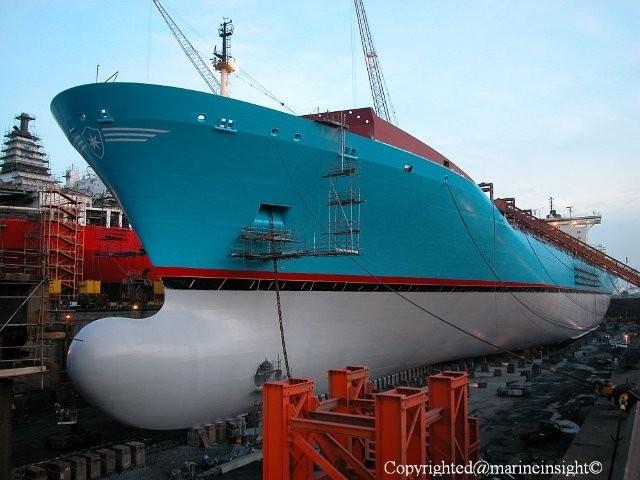



A floating dock is in the form of a “U” structure which is mainly used in salvage, to carry ships that have met with an accident and are damaged to an extent that has made them unable to sail further to a coastal dock.
However, now many regular sea-going, small and mid-size vessels are also dry docking in a floating dock. Several “U” type floating docks can be joined to carry a large vessel.
The ship is brought near the channel where the floating dry dock will partly submerge itself and the ship slides inside the dock.
Once the ship is in the position, the floating dock is then de-ballasted to drain the water from its hollow floors and walls to support the vessel on the blocks arranged on the floor of the floating dock.
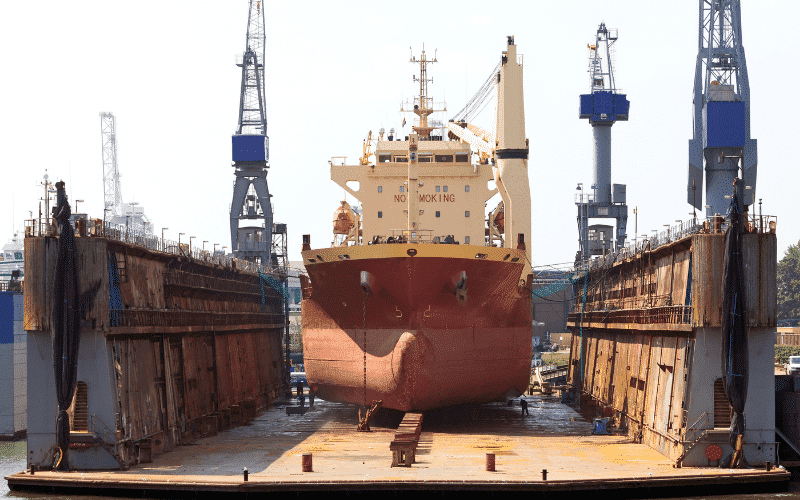

A valve is provided which can be opened to fill up the chambers with water and which will make the dock immersed in water so that the ship can sail out.
The water is pumped out of the chamber which will allow the dry dock to rise, exposing the underwater area of the ship for maintenance or carrying the ship repairs.
Related Read: What is Ballasting and De-ballasting?
The floating dry dock is usually built using steel framing which is similar to that of seagoing vessels with ballast tanks provided on sides and bottom to raise and lower the dock.
The floating dry docks are commonly operated in sheltered harbours as there is no wave or natural tidal activities present there.
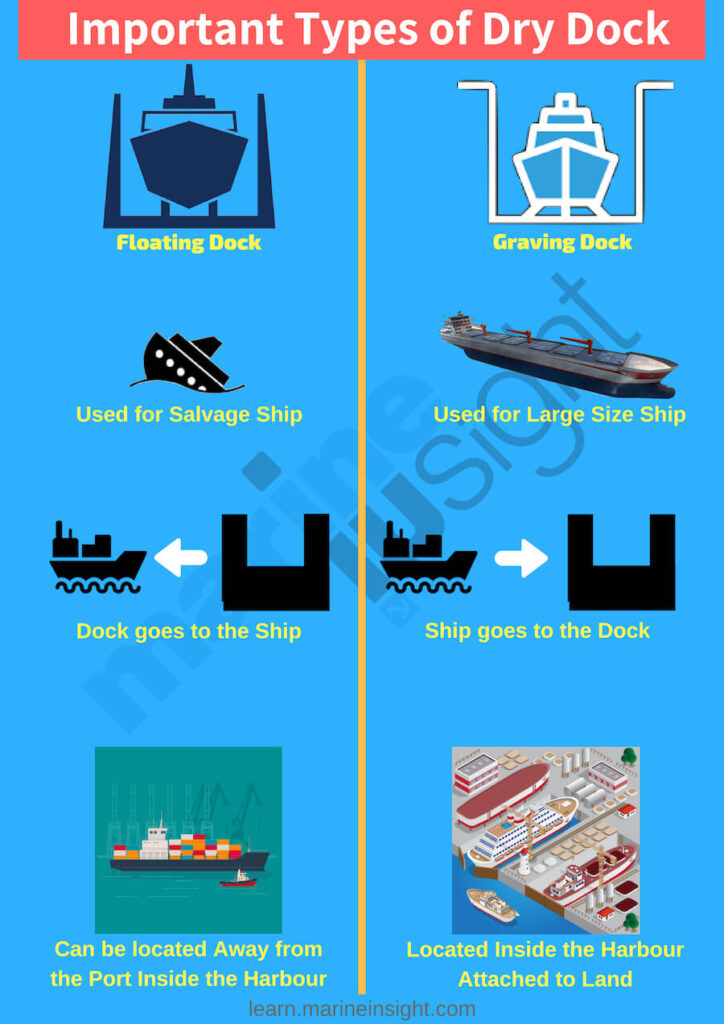

The blocks inside the dry dock play a very critical role in taking the ship’s load and distributing it among the number of blocks placed below the keel plates. Every ship is provided with a docking manual which will provide a guide block plan approved by the Ship Classification Society.
The shipmaster/ chief officer and the dry dock master must understand the blocking plan for the particular vessel and how the ship will behave under load when resting on the blocks, which include various factors that can affect the amount of load taken by a block.
The blocks are usually constructed from one material as the stiffness of all the blocks will be similar. If the blocks are constructed from different materials, the force exerted on the blocks with a smaller elasticity module will squeeze it more as compared to the block which is stiffer. This can lead to damage to the block or the ship’s hull as the distribution of the force will be uneven.
The most common material used for the blocks are:
In timber block, which is added into a keel track built of blocks with concrete or steel bases, the timber block will take a much smaller load as compared to the others.
Apart from the keel blocks, side blocks are also arranged to support the ship. They are less stiffer than the keel blocks as a stiffer side block will overload the vessel and may damage the structure. The height of the slide blocks is usually similar or more than that of the keel blocks.
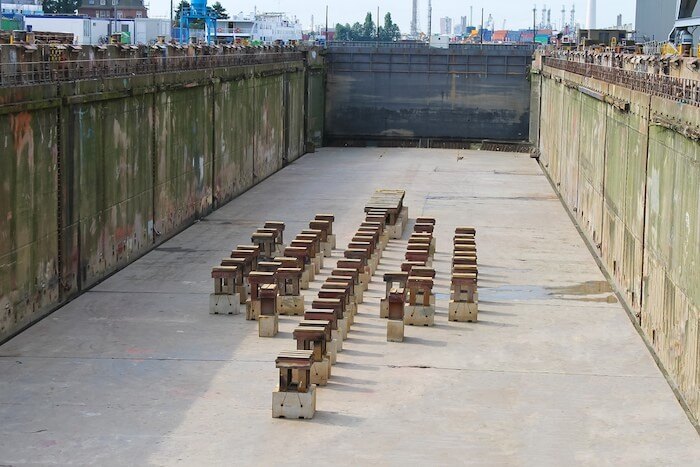

The criteria to select a type of dry dock for a ship depends on the following factors:
Related Read: How Cost Estimation is done for Ship’s Dry Dock?
Stability is the most important requirement for getting a ship safely into a dry dock. The three important parameters which must be ensured before entering the dry dock are:
1) Adequate Initial GM:
When the ship touches the blocks, there is a reaction at the point of contact which raises the centre of gravity “G” and reduces the metacentric height “G.M” so that adequate initial metacentric height is required to compensate the same.
2) Vessel to be Upright:
While entering the dock the vessel needs to be upright, which means that there should be no port or starboard list when the ship touches the blocks. If the point of contact of the ship and keel blocks is outside the centre line of a vessel, it may force the vessel to tip over.
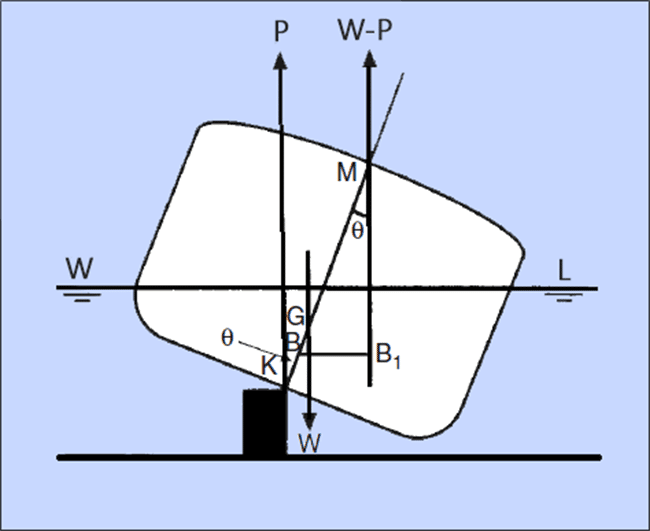

3) Small or Moderate Trim Aft:
A moderate trim aft is usually kept when making the ship’s keel sit on the keel block. As the water level in the dock lowers, the slight trim allows accending of stern and bow in tandem rather than simultaneously which will reduce the load and pressure on a hull and the keel of a vessel.
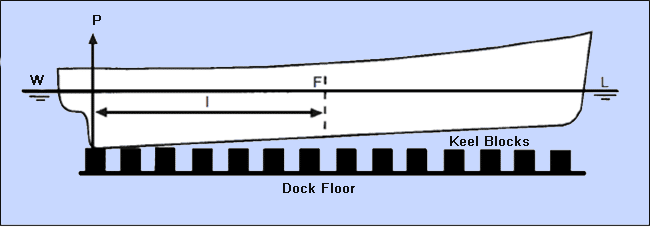

Related Read: 10 Types of Dry Dock Accidents That Can Occur in Ship’s Engine Room
Once the type of dry dock is selected by the ship manager, the next process is to prepare the ship to enter the dry dock and later place the ship’s keel carefully on the blocks provided in the dry dock floor. Some important points to note are:
Related Read: Dry Docking of Ships – Understanding Stability And Docking Plan
While dry-docking the ship, the duty of the ship’s crew (under the guidance of chief engineer and chief officer) will be:
Related Read:
Drydocking is one operation that allows the ship’s crew to learn those areas of the ship which cannot be explored when the ship is sailing.
It also helps the ship manager to assess the condition of the ship’s hull and those machineries which are not accessible when the ship is in water.
Bringing the ship to the dry dock is a team effort between the ship’s crew and dry dock personnel. Proper communication is the key to the safe laying of the ship’s keel on the keel blocks.
Disclaimer: The authors’ views expressed in this article do not necessarily reflect the views of The Marine Learners. Data and charts, if used, in the article have been sourced from available information and have not been authenticated by any statutory authority. The author and The Marine Learners do not claim it to be accurate nor accept any responsibility for the same. The views constitute only the opinions and do not constitute any guidelines or recommendation on any course of action to be followed by the reader.
The article or images cannot be reproduced, copied, shared or used in any form without the permission of the author and The Marine Learners.










We believe that knowledge is power, and we’re committed to empowering our readers with the information and resources they need to succeed in the merchant navy industry.
Whether you’re looking for advice on career planning, news and analysis, or just want to connect with other aspiring merchant navy applicants, The Marine Learners is the place to be.